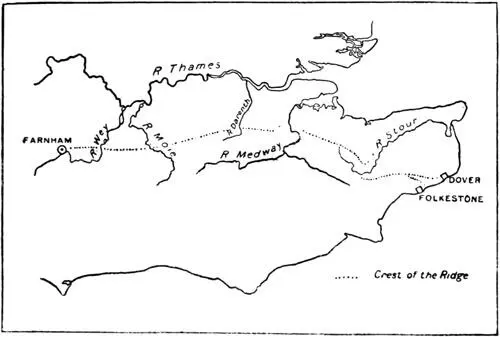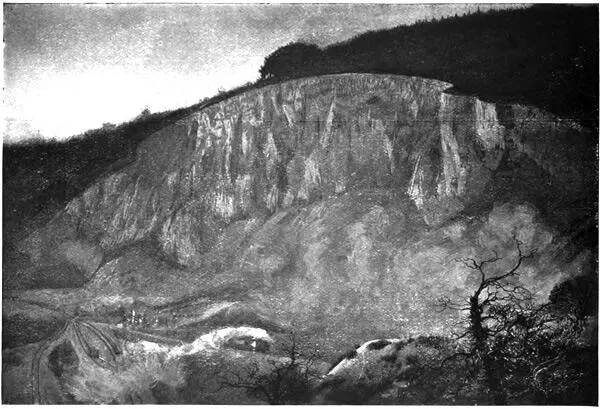There is more. It was along the green-sand ridge of south England that neolithic man had his principal seat. The getting of iron sprang up before history on the red stone of the Sussex weald; it remained there till our grandfathers' time. The oaks that grew from Kent to Devon, along so many creeks from the Rother to the Tamar, built our first ships. They remained our resource for this industry till the Napoleonic wars. The Victory was launched in Beaulieu River, and the first eye-witness, Caesar, heard that in cultivation the south had preceded the north.
6. Finally, not only was the district the best in England to develop an important road, but the platform or site for that road was ready provided, and invited use much more definitely than did any other way from the narrow seas up into the island.
* * * * *
With this last point I am led to describe the natural causeway which seems to call for a traveller landing in Kent to use it if he would go westward, or for one leaving the inland country to use it as the last part of his journey eastward towards the sea—I mean those heights which are called in their entirety the North Downs.
There runs from the neighbourhood of the Straits of Dover right across south England, in a great bow, a range of hills which for its length, unchanging pattern and aspect, has no exact parallel in Europe.
A man who should leave the Straits with the object of reaching the Hampshire centres would find a moderately steep, dry, chalky slope, always looking full towards the southern sun, bare of trees, cut by but three river valleys (and but one of these of any width), not often indented with combes or projecting spurs: this conspicuous range would lead him by the mere view of it straight on to his destination.

When you have turned the corner of the valley of the Stour, you can see for miles and miles the Kentish Downs like a wall pointing on over the Medway to Wrotham and the villages beyond. When you reach that projecting shoulder of Wrotham Hill you can still see on for miles and miles the straight, clean-cut embankment of chalk inviting you to pursue it westward at such a height as will clear the last cultivation of the valleys, and as will give you some view of your further progress. The end of each day's march is clearly apparent from the beginning of it, and the whole is seen to lie along this astonishingly homogeneous ridge. You do not lose that advantage for perhaps four days of going until you reach the valley of the Wey and the Guildford Gap; and even then for many miles further, though no longer on the chalk but on the sand, a sharp hillside, still looking at the sun, is afforded you in the Hog's Back.
You may say that from the Straits of Dover to Farnham, Nature herself laid down the platform of a perfectly defined ridge, from which a man going west could hardly deviate, even if there were no path to guide him.

THESE PITS WHICH UNCOVER THE CHALK BARE FOR US
See page 191
From Farnham to the converging point near Salisbury, where he would meet the northern, the western, and the south-western roads, no definite ridge continued; but high rolling downs of chalk gave him good enough going, and led him along a water-parting which saved him the crossing of rivers, and afforded for his last two or three days a dry and firm soil.
Such, we must presume, was the full course of the original Road from east to west. To put it the other way round, and give from west to east the primeval track from the centre of south England to the Straits of Dover, we may say that it would leave Stonehenge to enter Hampshire near Quarley Hill, leave Bury Hill Camp on the right, pass near Whitchurch, and so proceeding eastward, following the southern edge of the watershed, would enter Farnham by the line of 'Farnham Lane'; it would thence follow the southern side of the range of hills until it reached the sea above the Portus Lemanis—the inlet which covered the marshy plain below the present village Lympne.
Such was undoubtedly the earliest form of the Old Road, but upon this original trajectory two exceptions fell in a time so remote that it has hardly left a record. The western end of the Road was deflected and came to spring, not from Stonehenge, but from the site of Winchester; the eastern portion was cut short: it terminated, not at some port, but at Canterbury, inland.
Why did Winchester come to absorb the traffic of the west, and to form the depôt and the political centre of southern England? Why did Canterbury, an inland town, become the goal of this long journey towards the narrow seas?
The importance of the one and of the other can be explained. Let me take them in order, and begin first with Canterbury.
The Causes of the Development of Winchester and Canterbury, and of their Position as Termini of the Old Road
The Straits of Dover fill the history of this island because they have afforded our principal gate upon a full life.
All isolated territories—valleys difficult of entry, peninsulas, islands—have this double quality: they are not sufficient to live a full life of themselves, but, receiving sufficient material of civilisation from the larger world outside, they will use it intensively and bring it to the summit of perfection.
Cut off, they wither. Nowhere does humanity fall more abject and lethargic than in such defended places, if the defence be too long maintained. But let them admit from time to time the invasion of armies or ideas, and nowhere does humanity flourish more densely or higher. The arts, the fierce air of patriotism, in whose heat alone the gems of achievement can form, the solution of abstract problems, the expression of the soul in letters—for all these things seclusion provides a special opportunity. It protects their origins from the enemies of seeds, it nurtures their growth with the advantage of a still air, it gives them a resting-place for their maturity.
The valleys prove my thesis. The abandoned valleys of Savoy and Piedmont are goitrous, smitten, sterile. They are the places where, in the Middle Ages, vapid degradations of religion (the Waldensian for instance) could arise; they are the back-waters of Europe. Contrast with them the principal and open valleys; the valley of the Grésivaudan, a trench sown with wealth and vigour, the dale which is the backbone of strong Dauphiné, or that valley of the Romanche from which the Revolution sprang, or that of the Ticino which comes down from the Alps to the Italian plain, rejoicing like a virgin stepping forward into the ample day of her womanhood, arms open and all informed with life. Remember the Limagne and the Nemosian vineyard; I could think that God had made these half-secluded places to prop up our fading memories of Paradise.
And as the valleys, so the islands also prove it. Consider Crete, Cyprus, Sicily—for the matter of that our own island—what they can be when they are linked with neighbouring civilisation, and what when they are cut off.
The place of landing, therefore, is always capital and sacred for islands, and with us that place was chiefly the Kentish shore.
It might seem natural that some special haven upon that shore should absorb our traditions and receive our principal road. It was not so. Canterbury, and no port, received that road and became the nucleus of worship in the island. Why?
Canterbury, and not some port, is the terminus of the Old Road, on account of the effect of the tide in the Straits of Dover. The bastion of Kent, jutting out into the sharpest current of the narrow seas, distorts and confuses the violent tides of the Channel. Now complexity of tides involves a multiplicity of harbours, and many neighbouring harbours among which seamen choose as necessity may drive them, involve a common centre inland.
Читать дальше














